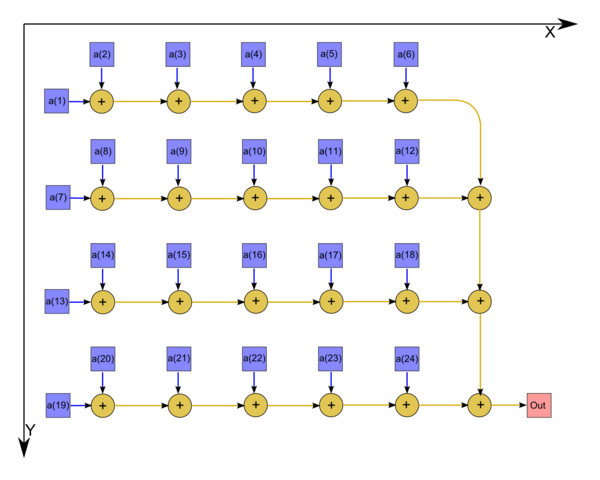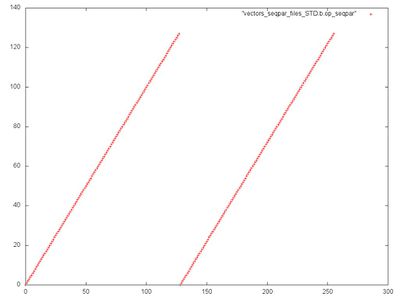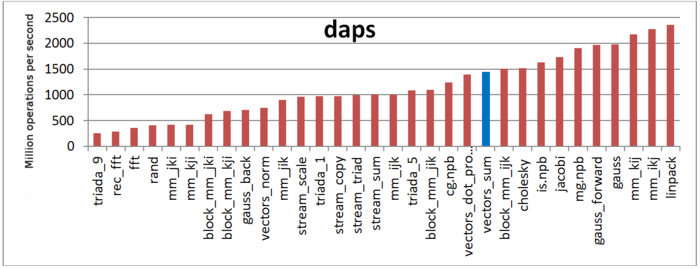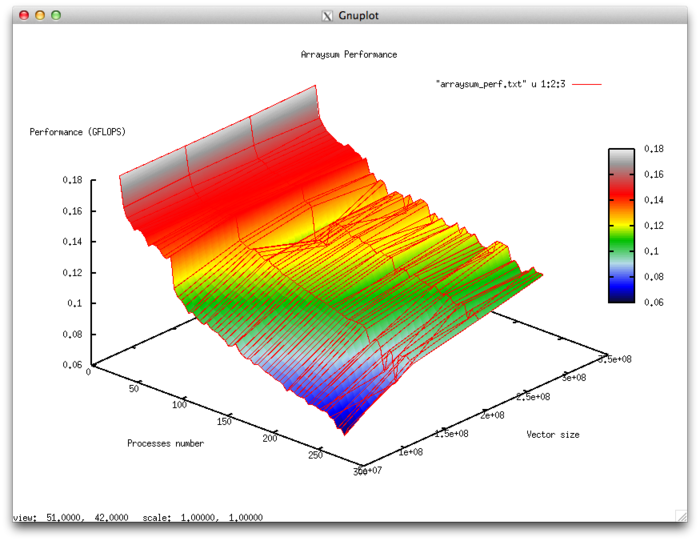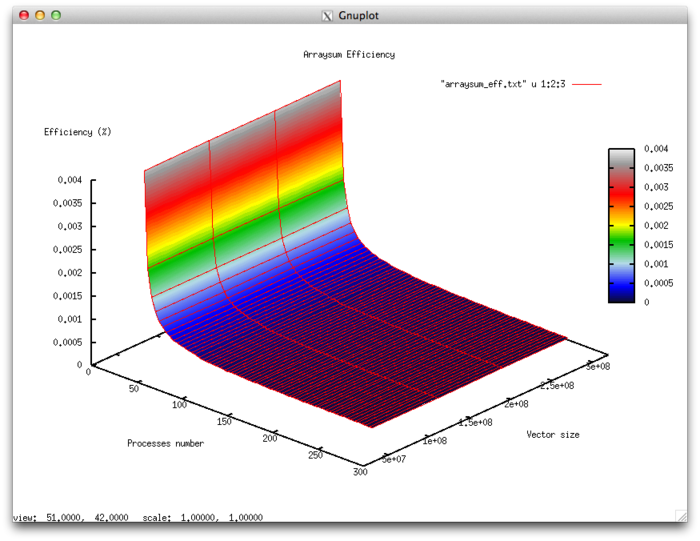The serial-parallel summation method
Primary authors of this description: A.V.Frolov, Vad.V.Voevodin (Section 2.2), A.M.Teplov (раздел Section 2.4)
Contents
- 1 Properties and structure of the algorithm
- 1.1 General description of the algorithm
- 1.2 Mathematical description of the algorithm
- 1.3 Computational kernel of the algorithm
- 1.4 Macro structure of the algorithm
- 1.5 Implementation scheme of the serial algorithm
- 1.6 Serial complexity of the algorithm
- 1.7 Information graph
- 1.8 Parallelization resource of the algorithm
- 1.9 Input and output data of the algorithm
- 1.10 Properties of the algorithm
- 2 Software implementation of the algorithm
- 2.1 Implementation peculiarities of the serial algorithm
- 2.2 Locality of data and computations
- 2.3 Possible methods and considerations for parallel implementation of the algorithm
- 2.4 Scalability of the algorithm and its implementations
- 2.5 Dynamic characteristics and efficiency of the algorithm implementation
- 2.6 Conclusions for different classes of computer architecture
- 2.7 Existing implementations of the algorithm
- 3 References
1 Properties and structure of the algorithm
1.1 General description of the algorithm
The serial-parallel method is used as a substitute for the block implementation of calculating long sequences of associative operations (for instance, mass summations). The method became popular due to the following features: a) it realizes the conversion of single cycles into double ones; b) on serial computers and for certain operations, the method was able to reduce the impact of round-off errors at the results. Here, we describe its version for summing numbers.
1.2 Mathematical description of the algorithm
Input data: one-dimensional array of [math]N[/math] numbers.
Output data: sum of the array's elements.
Formulas of the method: the integer [math]N[/math] is represented as [math]N = (p - 1) k + q[/math], where [math]p[/math] is the number of processors, [math]k = \lceil \frac{N}{p} \rceil[/math], and [math]q = N - k (p - 1)[/math].
Then the [math]i[/math]-th processor (where [math]i \lt p[/math]) calculates, in a serial mode, the sum of array elements with the indices ranging from [math](i - 1) k + 1[/math] to [math]i k[/math].
- [math]S_i = \sum_{j = 1}^k x_{k (i - 1) + j}[/math]
The [math]p[/math]-th processor calculates, in a serial mode, the sum of array elements with the indices ranging from [math](p - 1) k + 1[/math] to [math](p - 1) k + q[/math].
- [math]S_p = \sum_{j = 1}^q x_{k (p - 1) + j}[/math]
When this process is completed, the processors exchange their data, and one of them (or each of them if the result is later needed to all the processors) adds the partial sums in a serial mode.
- [math]\sum_{i = 1}^p S_i[/math]
1.3 Computational kernel of the algorithm
The computational kernel of the serial-parallel summation method can be compiled from multiple calculations of partial sums (altogether [math]p[/math] calculations)
- [math]S_i = \sum_{j = 1}^k x_{k (i - 1) + j}[/math]
plus the addition of these partial sums
- [math]\sum_{i = 1}^p S_i[/math]
1.4 Macro structure of the algorithm
As already noted in the description of the computational kernel, the basic part of the method is compiled of multiple calculations (altogether [math]p + 1[/math] calculations) of the sums
- [math]S_i = \sum_{j = 1}^k x_{k (i - 1) + j}[/math] and
- [math]\sum_{i = 1}^p S_i[/math]
1.5 Implementation scheme of the serial algorithm
The formulas of the method are given above. The summations can be performed in different ways, with indices of the summands either increasing or decreasing. When no special reasons for reordering are present, the natural order (i.e., increasing indices) is usually used.
1.6 Serial complexity of the algorithm
Let an array of [math]N[/math] elements must be summed. Various decompositions of [math]N[/math] differ from each other merely by arrangements of parentheses in the summation formula. The number of operations is the same for all the arrangements and is equal to [math]N - 1[/math]. Therefore, in terms of the number of serial operations, the method should be regarded as a linear complexity algorithm.
1.7 Information graph
The algorithm graph is shown in fig.1 in the case where an array of size 24 is summed.
Interactive representation of the algorithm graph in the case where an array of size 24 is summed. No input and output data are shown.
1.8 Parallelization resource of the algorithm
In order to sum an array of size [math]n[/math] by using the serial-parallel summation method in a parallel mode, the following layers must be performed:
- [math]k - 1[/math] layers for the summation of parts of the array ([math]p[/math] branches),
- [math]p - 1[/math] summation layers (a single serial branch).
Thus, in the parallel version, the critical path of the algorithm (and the corresponding height of the parallel form) depends on the chosen splitting of the array. In the optimal case ([math]p = \sqrt{n}[/math]), the height of the parallel form is [math]2 \sqrt{n} - 2[/math].
Consequently, in terms of the parallel form height, the serial-parallel summation method is qualified as an algorithm of the square root complexity. In terms of the parallel form width, it also has the square root complexity.
1.9 Input and output data of the algorithm
Input data: array [math]\vec{x}[/math] (with elements [math]x_i[/math]).
Further restrictions: none.
Size of the input data: [math]N[/math].
Output data: sum of the array's elements.
Size of the output data: single scalar.
1.10 Properties of the algorithm
It is clearly seen that, in the case of unlimited resources, the ratio of the serial to parallel complexity has the square root order (the ratio of the linear to square root complexity). The computational power of the algorithm, understood as the ratio of the number of operations to the total size of the input and output data, is only 1 (the size of the input and output data is equal to the number of operations). The algorithm is not completely determined because the partial summations can be organized in different ways. Choosing the order of performing associative operations in accordance with the peculiarities of the input data may reduce the impact of round-off errors at the result. The edges of the information graph are local.
2 Software implementation of the algorithm
2.1 Implementation peculiarities of the serial algorithm
The simplest variant (with no order of summation changed) can be written in Fortran as follows:
DO I = 1, P
S (I) = X(K*(I-1)+1)
IF (I.LQ.P) THEN
DO J = 2,K
S(I)=S(I)+X(K*(I-1)+J)
END DO
ELSE
DO J = 2,Q
S(I)=S(I)+X(K*(I-1)+J)
END DO
END IF
END DO
SUM = S(1)
DO I = 2, P
SUM = SUM + S(I)
END DO
One can also write a similar scheme with the summations performed in the reverse order. We emphasize that, for both schemes, the algorithm graph is the same!
2.2 Locality of data and computations
2.2.1 Locality of implementation
2.2.1.1 Structure of memory access and a qualitative estimation of locality
Fig.2 shows the memory address profile for summing the elements of an array. This profile consists of accesses to two arrays; the fragments for individual arrays are highlighted in green in Fig.2. Since we discuss the serial implementation of the serial-parallel summation method, the profile structure is practically independent of the number of branches chosen – only the number of elements involved in fragment 1 will be different.
Fragment 2 has a very simple structure; it represents a serial search of all array elements. Fragment 1 consists of two identical serial searches of all array elements. This is clearly seen in Fig.3, which gives a separate picture of this fragment.
This fragment is characterized by high spatial locality and low temporal locality since practically no repeated calls to elements are done.
2.2.1.2 Quantitative estimation of locality
The main implementation fragment, which is used in all quantitative assessments, is shown here [1](KernelOpSeqpar function). Launch conditions are described here [2].
The first estimate is based on daps, which assesses the number of memory access operations (reads and writes) per second. Similar to flops, daps is used to evaluate memory access performance rather than locality. Yet, it is a good source of information, particularly for comparison with the results provided by the next estimate cvg.
Fig.4 shows daps values for implementations of popular algorithms, sorted in ascending order (the higher the daps, the better the performance in general). It is seen that these values are sufficiently high, and they are close to those for the serial-parallel dot product of two vectors. This is not surprising because both procedures execute operations of the same type.
Вторая характеристика – cvg – предназначена для получения более машинно-независимой оценки локальности. Она определяет, насколько часто в программе необходимо подтягивать данные в кэш-память. Соответственно, чем меньше значение cvg, тем реже это нужно делать, тем лучше локальность.
На рис.5 приведены значения cvg для того же набора реализаций, отсортированные по убыванию (чем меньше cvg, тем в общем случае выше локальность). Можно увидеть, что, согласно данной оценке, локальность профиля достаточно высока, что коррелирует со значением оценки daps.
2.3 Possible methods and considerations for parallel implementation of the algorithm
2.4 Scalability of the algorithm and its implementations
2.4.1 Scalability of the algorithm
2.4.2 Scalability of of the algorithm implementation
Набор изменяемых параметров запуска реализации алгоритма и границы значений параметров алгоритма:
- число процессоров [2 : 256]
- размер вектора [80000000:320000000]
Эффективность выполнения реализации алгоритма
- Минимальная эффективность 0,00004%
- Максимальная эффективность 0,0037%
Оценка масштабируемости
- По числу процессов: -9.432e-07 – при увеличении числа процессов эффективность уменьшается на рассмотренной области изменений параметров запуска, однако, в целом уменьшение не интенсивное. Это объясняется тем, что при увеличении числа процессов сильно возрастает доля накладных расходов на организацию схемы сдваивания сумирования, однако, так как общая эффективность составляет доли процента интенсивность сильная только при переходе от работы процессов в рамках одного физического узла к использованию коммуникационной сети. В остальной области рассмотренных значений параметров запуска эффективность близка к 0 в силу того, что на каждый процесс приходится черезвычайно малая доля вычислений. Больше полезного времени уходит на организацию работы процессов.
- По размеру задачи: 1.881e-06 – при увеличении размера задачи эффективность в целом очень незначительно увеличивается по рассматриваемой области. Это объясняется общим увеличением вычислительной сложности задачи в связи с увеличением размерности. Однако вычислительная сложность алгоритма [math](N-1)[/math]не позволяет существенно увеличить долю времени затрачиваемую на вычисления.
- По двум направлениям: -1.423e-07 – при рассмотрении увеличения, как вычислительной сложности, так и числа процессов по всей рассмотренной области значений уменьшается, однако интенсивность уменьшения эффективности небольшая. В совокупности с тем фактом, что разница между максимальной и минимальной эффективностью на рассмотренной области значений параметров несущественная говорит о том, что на поверхности присутствуют области с очень интенсивным изменением эффективности на участке 2-16 процессов, но очень малые по площади. На остальной поверхности изменения эффективности незначительны и находятся на приблизительно одном и том же уровне.
Исследованная реализация алгоритма на языке C
2.5 Dynamic characteristics and efficiency of the algorithm implementation
2.6 Conclusions for different classes of computer architecture
2.7 Existing implementations of the algorithm
В чистом виде алгоритм последовательно-параллельного метода для суммирования массива встречается редко, в основном встречаются его модификации, например для случаев вычисления скалярного произведения (вместо элементов массива будут фигурировать произведения элементов двух массивов), равномерной нормы (вместо элементов массива — их модули) и т. п. В случае вычисления скалярного произведения в одном из частных случаев подобный приём применён в библиотеке BLAS (там одна из размерностей равна 5), но, видимо, не для распараллеливания, а для оптимизации работы с регистрами процессора. Между тем, разбиения массивов на группы для вычислений частных сумм могут быть полезны и для лучшего использования кэша на отдельных узлах.
